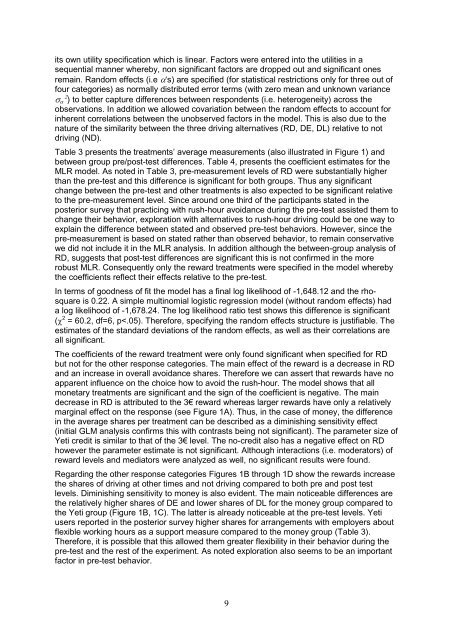Ben-Elia, E. and Ettema, D. (2011) Changing commuters' behav- ior ...
Ben-Elia, E. and Ettema, D. (2011) Changing commuters' behav- ior ...
Ben-Elia, E. and Ettema, D. (2011) Changing commuters' behav- ior ...
Create successful ePaper yourself
Turn your PDF publications into a flip-book with our unique Google optimized e-Paper software.
its own utility specification which is linear. Factors were entered into the utilities in a<br />
sequential manner whereby, non significant factors are dropped out <strong>and</strong> significant ones<br />
remain. R<strong>and</strong>om effects (i.e ‘s) are specified (for statistical restrictions only for three out of<br />
four categories) as normally distributed error terms (with zero mean <strong>and</strong> unknown variance<br />
) to better capture differences between respondents (i.e. heterogeneity) across the<br />
observations. In addition we allowed covariation between the r<strong>and</strong>om effects to account for<br />
inherent correlations between the unobserved factors in the model. This is also due to the<br />
nature of the similarity between the three driving alternatives (RD, DE, DL) relative to not<br />
driving (ND).<br />
Table 3 presents the treatments’ average measurements (also illustrated in Figure 1) <strong>and</strong><br />
between group pre/post-test differences. Table 4, presents the coefficient estimates for the<br />
MLR model. As noted in Table 3, pre-measurement levels of RD were substantially higher<br />
than the pre-test <strong>and</strong> this difference is significant for both groups. Thus any significant<br />
change between the pre-test <strong>and</strong> other treatments is also expected to be significant relative<br />
to the pre-measurement level. Since around one third of the participants stated in the<br />
poster<strong>ior</strong> survey that practicing with rush-hour avoidance during the pre-test assisted them to<br />
change their <strong>behav</strong><strong>ior</strong>, exploration with alternatives to rush-hour driving could be one way to<br />
explain the difference between stated <strong>and</strong> observed pre-test <strong>behav</strong><strong>ior</strong>s. However, since the<br />
pre-measurement is based on stated rather than observed <strong>behav</strong><strong>ior</strong>, to remain conservative<br />
we did not include it in the MLR analysis. In addition although the between-group analysis of<br />
RD, suggests that post-test differences are significant this is not confirmed in the more<br />
robust MLR. Consequently only the reward treatments were specified in the model whereby<br />
the coefficients reflect their effects relative to the pre-test.<br />
In terms of goodness of fit the model has a final log likelihood of -1,648.12 <strong>and</strong> the rhosquare<br />
is 0.22. A simple multinomial logistic regression model (without r<strong>and</strong>om effects) had<br />
a log likelihood of -1,678.24. The log likelihood ratio test shows this difference is significant<br />
( 2 = 60.2, df=6, p

















